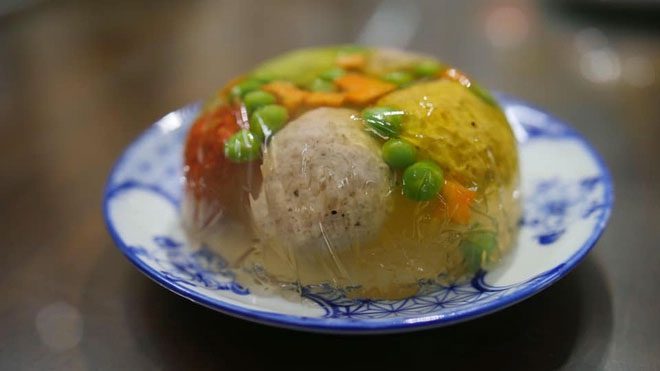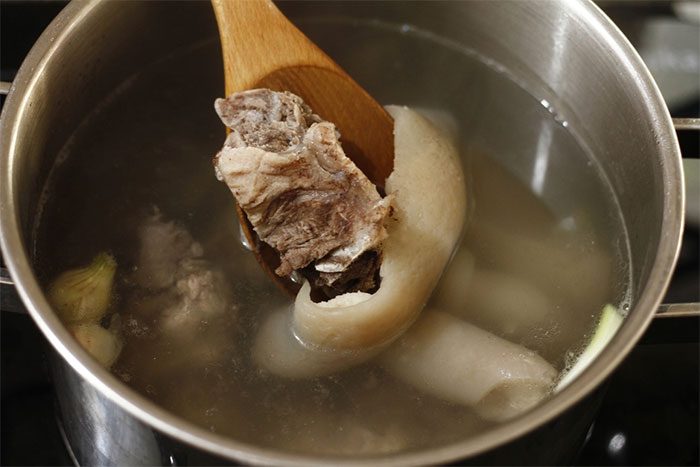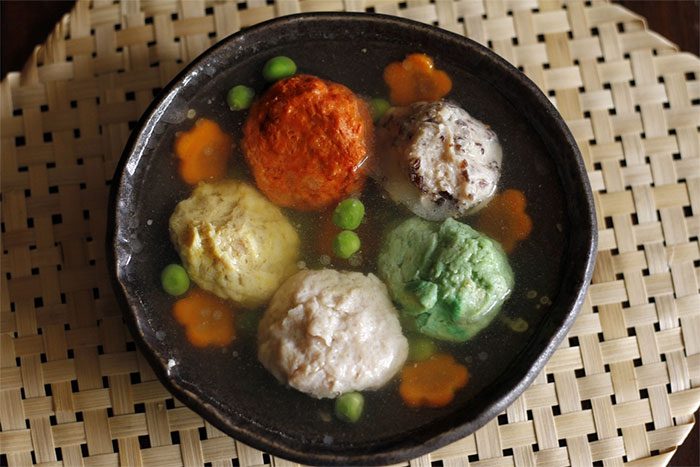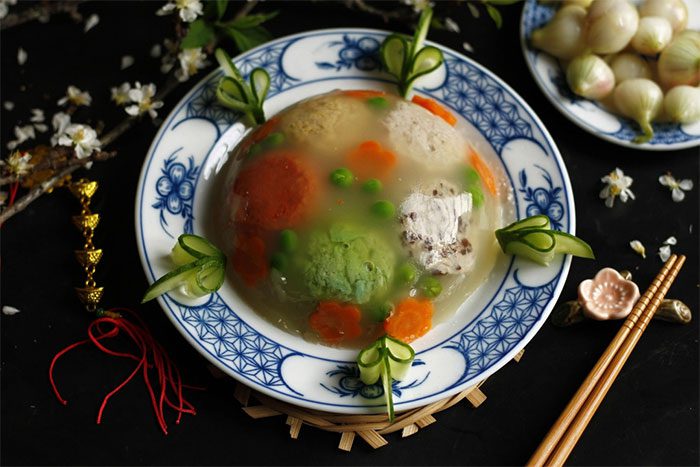“Mọc vân ám” is a distinctive dish from ancient Hanoi’s cuisine, requiring meticulousness and expertise in both preparation and cooking to create a unique dish with an exquisite flavor.
The Vietnamese take pride in their rich culinary culture steeped in tradition. Over time, many delightful dishes have emerged, but some have left a lasting impression in our collective memory, stirring a longing to rediscover those old flavors.
Bát Tràng of ancient Hanoi is famous for its bamboo shoot and squid soup, used to “release bad luck” – a ritual for good fortune during the worship of the Kitchen Gods and on the eve of the Lunar New Year. However, few people remember another delicious dish that has gradually faded into the past: the “mọc vân ám.”
Mọc Vân Ám – The Essence of Ancient Hanoi Cuisine
It can be said that mọc vân ám embodies the quintessence and spirit of ancient Thang Long cuisine. The complexity and finesse involved in each step of creating this dish highlight the artistry of the Hanoians.

Mọc vân ám, a beautiful name for a dish that is actually a jelly meat.
Mọc vân ám resembles a cloud of white covering colorful pearls inside. In fact, it consists of a layer of jelly made from pork skin enveloping five colorful mọc pieces, symbolizing the balance of Yin and Yang and the Five Elements. How are these colored pieces created, and what do they have to do with the distant theories of Yin-Yang and the Five Elements?
While it is also a type of jelly, creating the dish “mọc vân ám” requires significant effort. From selecting the ingredients, dyeing the mọc, cooking, and molding, every step requires the meticulous craftsmanship of the cook. To achieve the final product, the outer layer must be transparent (made from simmered pork skin and bones), resembling clouds (vân ám) that envelop the colorful mọc pieces within.

Mọc vân ám, a traditional New Year dish steeped in the theories of the Five Elements.
Perhaps due to its complexity, this traditional New Year dish has become scarce on festive tables in today’s busy lifestyle. Few can cook it to the authentic flavor of the past. It is believed that preparing a delicious mọc vân ám not only requires cooking skills but also a deep understanding of culinary arts and a profound love for the homeland.
Cooking mọc vân ám is a test of dedication to culinary arts. Nowadays, people are truly busy; many households are still occupied until the afternoon of the Lunar New Year’s Eve, making it hard to find time to prepare such a meticulous dish. Some cook jelly meat, while others opt for frozen mọc, and some even order ready-made trays for convenience, leaving no time to “linger” over such a complicated dish.
Preparing Mọc Vân Ám is Indeed Intricate and Detailed…
Ancient Hanoians were always refined in their cooking gestures and skilled in dyeing colors from natural ingredients. The red of gấc (a type of fruit), the green of pandan leaves, the yellow of gardenia seeds, the black of shiitake mushrooms and wood ear mushrooms, and the ivory white from raw pork sausage are all easily available ingredients, aren’t they? However, in the past, the green was not derived from pandan leaves but from the natural color of the mảnh cộng leaves.

Mảnh cộng, also known as bìm bịp or monkey bone, has a sweet flavor in traditional medicine and is believed to detoxify the liver and cool the body. (Photo: Bùi Thủy).
Raw pork sausage serves as the base for the mọc, which isn’t simply ground meat but must include raw sausage mixed with clean, fat-free pork skin in a specific ratio, minced together with white wood ear mushrooms, white pepper, and a few other spices until it reaches a sticky consistency before dividing it for dyeing.
The colored mọc pieces will be steamed separately for each color, not steamed together, and definitely not boiled.
The jelly broth adds another layer of complexity. It requires patience and calmness, without rushing. This broth will determine whether the dish is considered “quintessential” or not. The broth must be clear and slightly opaque, allowing the colorful mọc pieces to be visible. If the broth is cloudy and murky, the dish will lose its appeal.

Simmering the pork skin broth requires careful monitoring of heat and timing to avoid cloudiness. (Photo: Bùi Thủy).
Pork skin is rich in natural collagen, so it must be simmered gently. The skin should be cleaned of fat using salt, fresh lemon juice, and ginger juice to eliminate odors. Then, it must be blanched in hot water to remove impurities. Finally, the pork skin is placed in cold water with ginger and shallots, seasoned with a bit of salt.
The broth must be simmered over low to medium heat; boiling too vigorously will turn the broth cloudy, ruining the dish. The broth needs to be skimmed continuously until it thickens slightly; once the pork skin is sufficiently soft, it should be removed to let the clear broth settle.

The colorful mọc pieces are steamed separately, then placed in a small bowl and covered with the simmered pork skin broth. (Photo: Bùi Thủy).
When using pork skin and bones for the broth, they should come from high-quality, naturally raised pigs, not those fattened with growth enhancers. The bowl containing the mọc vân ám should be small and fit perfectly on a plate, rather than using a deep bowl. No cooking oil is used; a thin layer of lard should be rubbed inside the bowl to facilitate easy unmolding. Place peas and round carrot flowers blanched in boiling water at the bottom. Arrange five colored mọc pieces alternately, then gently pour the pork skin broth over to allow the dish to set. When serving, invert onto a plate and present it on the festive offering table for guests.
…but Rich in Meaning
The small, round, colorful plate of mọc vân ám carries significant meaning when placed on the festive table of the Hanoians. This dish does not have a specific recipe or exact measurements; its essence lies in the culinary experience of old Hanoi to achieve the most harmonious flavor.
A Dish Full of Heart and Soul
Why does mọc vân ám hold such significance on the New Year’s offering table? First and foremost, it embodies the dedication and care poured into each step. Every process must be meticulous and refined. For instance, achieving a jelly-like consistency is easy; just buy gelatin, and you save a lot of time. But if the jelly is exposed to air, it collapses, losing the beauty of a perfect, colorful cloud.
Many people wonder why achieving the green color is easy; can’t we just use blended pandan leaves or spinach? However, the green from mảnh cộng leaves is distinctly different; comparing them feels inadequate, leaving no room for the refinement. Yet nowadays, finding mảnh cộng leaves in the streets is becoming increasingly difficult, leading some to settle for substitutes.

Due to its complexity, the traditional New Year dish Mọc Vân Ám has faded into obscurity, making it difficult to recreate the old flavors. (Photo: Bùi Thủy).
A Dish That Converges Universal Essence
While the universe may seem distant, its significance in human life is quite close. The traditional dish mọc vân ám is delightful and precious because the five colored mọc pieces symbolize the Five Elements: Metal (represented by the ivory white of raw sausage), Wood (the green of mảnh cộng leaves, now often replaced with more accessible pandan or spinach), Water (the black of shiitake mushrooms and finely chopped wood ear mushrooms), Fire (the red of ripe gấc fruit), and Earth (the yellow of gardenia seeds).
The Five Elements theory reflects the dynamic nature of life, harmoniously applied to cuisine. This is also a philosophy of the ancient Vietnamese, symbolizing the passage of time through the four seasons: Spring (associated with Wood), Summer (with Fire), Autumn (with Metal), Winter (with Water), and the Four Quarters (the last month of each season, associated with Earth). The round bowl of mọc vân ám (Heaven) placed on a square plate (Earth) symbolizes the balance of Yin and Yang. When the bowl is placed on an oval plate, it resembles a bar of gold, symbolizing fortune and luck.
This symbolizes the hopes and aspirations for a fulfilling and prosperous life, with all wishes coming true. The dish mọc vân ám on the traditional offering table also represents the heartfelt devotion of descendants to their ancestors, deeply rooted in the principles of benevolence and the natural laws that lead to happiness.


















































